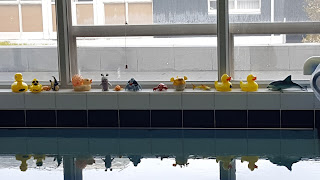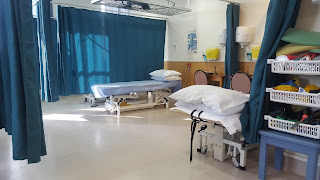This is my last placement on my journey to becoming a physiotherapist.
No two journeys will be the same.
 |
| Mt Studholm "Finish line is in sight" |
I've enjoyed my journey and would recommend the challenge to anybody wanting to make a difference to healthcare; improving the wellbeing of individuals' to improving the wellbeing of a nation. Quality of life, empowerment, education, wellbeing, movement... to name a few, these are the words to get excited about. Physiotherapists have the practical tools and knowledge to make a difference. Those that are caring and stay enthusiastic will make the biggest difference in their practice. Go the extra mile, it's a journey worth travelling. That is the impression I have as I submit my last clinical portfolio for marking.
 |
| Mt Studholm above the low cloud [insert metaphor about finishing the degree] |
Here's a glimpse of my last student placement:
The professional studies week (PSW round 2 for 2017) had the usual presentations from students who had completed their community/elective placement, a lecture on ethics, and pre-placement prep - which for acute care physio included the completion of a worksheet as a 'refresher' followed by observing a PT in the acute care setting. The highlight of the week, for me anyway, was the Marae visit. This was a highlight, not only because I was fortunate to receive a 2h mirimiri (traditional Maori massage) as the volunteer model for the education session on mirimiri. Rather, it showcased the opportunities that the physiotherapy profession has for improving the wellbeing of low socio-economic populations and for interacting with people that associate with Maori culture / for dealing with people of any cultural association. So to summarise and pay homage to what I learned on the marae I'll shed some light on mirimiri in the graphic below.
One key opportunity for the physiotherapy profession would be for physiotherapists to connect with their local Marae and discuss how they could best integrate their physio practice with the Maori community, whether it be by offering a clinic one day per week at the marae or by discussing how the leaders of the marae and the physio can best educate their community (e.g. information evening). MiriMiri is another means for helping the Maori community; the physiotherapist could oversee and collaborate in the training of a mirimiri practitioner at a local marae.
At the end of the PSW I drove the other student placed in Timaru up to her accommodation for her placement. I was fortunate to stay with my family in Waimate (35min drive to Timaru).
 |
| Timaru Public Hospital |
We were left orientation packs with our ID / access card at the reception of Timaru Hospital to pick-up over the weekend before placement started. On day one of placement we were met and shown around the facilities e.g. cafe, staff library, seminar rooms, departments etc and delivered to our supervisors who then orientated us to our wards / areas. I was placed on surgical/orthopaedic ward with additional ICU and emergency department roles.
 |
| 5th Floor, Surgical ward Physio Gym. |
Over the placement I got to see the majority of the hospital, including frequent visits to the orderlies area to issue crutches, and over to the orthotist workshop to have equipment modified (like aspen braces). The physio department had a hydrotherapy pool and outpatient area, as well as their own gym, office space and frames storage area.
 |
| Hydrotherapy pool |
 |
| ...Yes the hydrotherapy pool is like a giant bathtub. |
Orthotists workshop
 |
| PT outpatient area |
I was fortunate to experience another THJR surgery midway through the placement too!
I was fortunate to be invited to a multidisciplinary student 'INTERact' programme, which saw physio, medical and dietician students learn about the roles of the other students. The idea was to work through a document to facilitate our learning, perform an assessment and treatment as we normally would (allowing each of us to observe each other in practice), then debrief about what we learned and to clarify aspects of their practice we were curious about. The programme has great potential!
As per all placements, we had to give a presentation. I decided to give an informal guided discussion on falls (again, using last years research project). As you can see, I'm enjoying the use of infographics! I attended the in-service presentations by other physiotherapists over the placement too (Mulligans concept, an article review from the Hand Therapist, inpatient falls, and diagnosing vestibular conditions). nb. The best way to prevent inpatient falls is via information targetted to adult learning style about falls and an individualised approach for each patient targeting their risk factors for falls. In many cases, having the inpatient adult use the nurse call bell before mobilising was the most successful strategy for preventing inpatient falls.
My weekly schedule:
- Monday - MDT 10am, Zoom tutorial at 3.30pm with the other students completing their acute care physio placements in Dunedin, Invercargill and Balclutha.
- Tuesday - 12pm Dr's in-service presentations (nb don't need lunch on Tuesdays).
- Wednesday - 8:30am morning with clinical educator, 1pm ERAS 'knee class' for TKR.
- Thursday - MDT 10am, physio meeting / presentations 12pm.
- Friday - End of day weekend list.
My supervisor had been a physiotherapist for 40+ years, she had a wealth of experience and knowledge. Not only this, she had a passion for helping people, seeing the big picture and putting a smile on their dial. She can dance, sing, impersonate and joke (all whilst remaining professional). The patients appreciated her, the staff on surgical ward loved her. This made for the most enjoyable placement to date (what a great way to finish the degree). Furthermore, she still strives to improve processes at the hospital (e.g. on the ERAS committee etc) - what a hero!
The other PT staff were equally warm and welcoming. I spent most lunch breaks down in the physio department enjoying their company and having a good laugh.
My clinical educator was based in Timaru for this placement. She worked in private practice but had a great deal of experience working in the hospital setting, particularly in the UK. On the last week, we (my supervisor, clinical educator and myself) had a grand discussion that went on a tangent very quickly. We decided that mental health was a major determinant of falls / ...mental health was a determinant of many things, hospitals are associated with passivity with regards to patients taking control of their own recovery, falls prevention needs to be targeted by a wider group of institutions (e.g. schools, churches) and younger populations, and finished with talks about the human race, role of physio in the future and the demise of the world. Hah! The conversation seamlessly flowed from one topic to the next.
I had a number of interesting patients, but I will forgo telling you about them (with the exception of one tourist)... My supervisor and I had a Chinese tourist who sustained a leg fracture (the fracture details aren't important to the story) having stepped backwards off a walking track in Mt Cook national park to take a photo for another tourist. Communication was interesting, often using big body gestures to convey our message, and discharging the patient to a motel before they set-off back home was equally interesting. Anyway, the mechanism of injury had my supervisor and I talking about tramping, and mountaineering. By the end of the discussion, I had a movie to look up (which turned into a list by the time I started browsing mountaineering movies) and a person to look up. The person to google was New Zealander and physiotherapist, Lydia Bradey. Her claim to fame was the first woman to summit Mt Everest without supplementary oxygen. I must keep an eye out for her book 'Going up is easy' (2015). Here is an article from her book launch on Stuff.co.nz
Recommend to watch: Touching the Void (2003) | Everest (2015) | Beyond the edge (2013) | North face (2008) | Meru (2015).
 |
| Red tarns track, Mt Cook |
 |
| Peters point, looking toward Mt Cook during sunset |
Selfies on the last day of placement with Yanni!
 |
| 'high five' |
 |
| Snapchat filter. I'll attend the 'low-key' graduation in August. |
 |
| Sabella and I, above the cloud on route to Mueller hut. |
 |
| Yanni and I. Relaxing hike to Mueller hut after finishing our Timaru Placement! |
 |
| Mueller Hut with Mt Cook in the background. |
 |
| Mueller Hut 28th May 2017 |
 |
| 22 April Aurora Australis from parent's backyard |
 |
| Bells Pond (near Waimate) |
 |
| Autumn colours at Bell's Pond |












